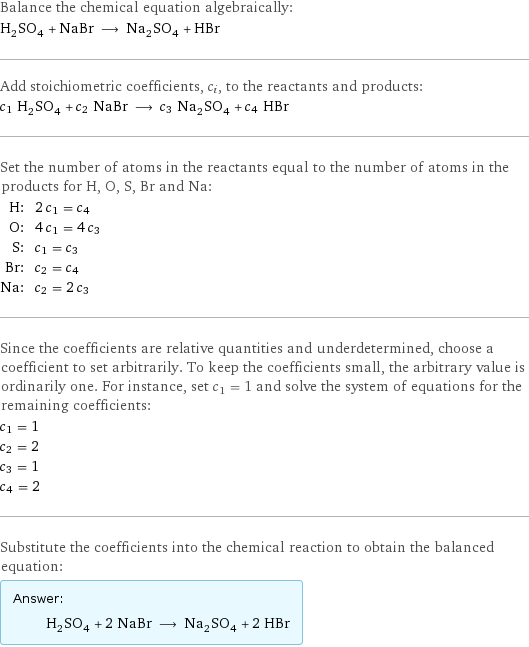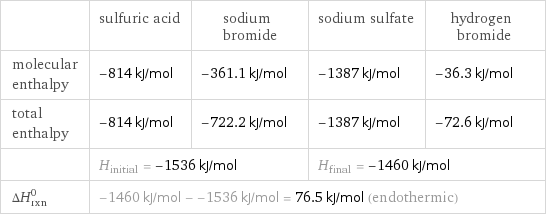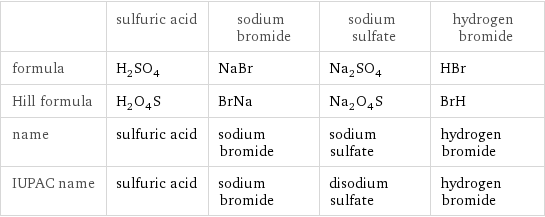Input interpretation

H_2SO_4 sulfuric acid + NaBr sodium bromide ⟶ Na_2SO_4 sodium sulfate + HBr hydrogen bromide
Balanced equation

Balance the chemical equation algebraically: H_2SO_4 + NaBr ⟶ Na_2SO_4 + HBr Add stoichiometric coefficients, c_i, to the reactants and products: c_1 H_2SO_4 + c_2 NaBr ⟶ c_3 Na_2SO_4 + c_4 HBr Set the number of atoms in the reactants equal to the number of atoms in the products for H, O, S, Br and Na: H: | 2 c_1 = c_4 O: | 4 c_1 = 4 c_3 S: | c_1 = c_3 Br: | c_2 = c_4 Na: | c_2 = 2 c_3 Since the coefficients are relative quantities and underdetermined, choose a coefficient to set arbitrarily. To keep the coefficients small, the arbitrary value is ordinarily one. For instance, set c_1 = 1 and solve the system of equations for the remaining coefficients: c_1 = 1 c_2 = 2 c_3 = 1 c_4 = 2 Substitute the coefficients into the chemical reaction to obtain the balanced equation: Answer: | | H_2SO_4 + 2 NaBr ⟶ Na_2SO_4 + 2 HBr
Structures

+ ⟶ +
Names

sulfuric acid + sodium bromide ⟶ sodium sulfate + hydrogen bromide
Reaction thermodynamics
Enthalpy

| sulfuric acid | sodium bromide | sodium sulfate | hydrogen bromide molecular enthalpy | -814 kJ/mol | -361.1 kJ/mol | -1387 kJ/mol | -36.3 kJ/mol total enthalpy | -814 kJ/mol | -722.2 kJ/mol | -1387 kJ/mol | -72.6 kJ/mol | H_initial = -1536 kJ/mol | | H_final = -1460 kJ/mol | ΔH_rxn^0 | -1460 kJ/mol - -1536 kJ/mol = 76.5 kJ/mol (endothermic) | | |
Gibbs free energy

| sulfuric acid | sodium bromide | sodium sulfate | hydrogen bromide molecular free energy | -690 kJ/mol | -349 kJ/mol | -1270 kJ/mol | -53.4 kJ/mol total free energy | -690 kJ/mol | -698 kJ/mol | -1270 kJ/mol | -106.8 kJ/mol | G_initial = -1388 kJ/mol | | G_final = -1377 kJ/mol | ΔG_rxn^0 | -1377 kJ/mol - -1388 kJ/mol = 11 kJ/mol (endergonic) | | |
Equilibrium constant
![Construct the equilibrium constant, K, expression for: H_2SO_4 + NaBr ⟶ Na_2SO_4 + HBr Plan: • Balance the chemical equation. • Determine the stoichiometric numbers. • Assemble the activity expression for each chemical species. • Use the activity expressions to build the equilibrium constant expression. Write the balanced chemical equation: H_2SO_4 + 2 NaBr ⟶ Na_2SO_4 + 2 HBr Assign stoichiometric numbers, ν_i, using the stoichiometric coefficients, c_i, from the balanced chemical equation in the following manner: ν_i = -c_i for reactants and ν_i = c_i for products: chemical species | c_i | ν_i H_2SO_4 | 1 | -1 NaBr | 2 | -2 Na_2SO_4 | 1 | 1 HBr | 2 | 2 Assemble the activity expressions accounting for the state of matter and ν_i: chemical species | c_i | ν_i | activity expression H_2SO_4 | 1 | -1 | ([H2SO4])^(-1) NaBr | 2 | -2 | ([NaBr])^(-2) Na_2SO_4 | 1 | 1 | [Na2SO4] HBr | 2 | 2 | ([HBr])^2 The equilibrium constant symbol in the concentration basis is: K_c Mulitply the activity expressions to arrive at the K_c expression: Answer: | | K_c = ([H2SO4])^(-1) ([NaBr])^(-2) [Na2SO4] ([HBr])^2 = ([Na2SO4] ([HBr])^2)/([H2SO4] ([NaBr])^2)](../image_source/c4338b14734ddbdca3e327e3ed4f4b02.png)
Construct the equilibrium constant, K, expression for: H_2SO_4 + NaBr ⟶ Na_2SO_4 + HBr Plan: • Balance the chemical equation. • Determine the stoichiometric numbers. • Assemble the activity expression for each chemical species. • Use the activity expressions to build the equilibrium constant expression. Write the balanced chemical equation: H_2SO_4 + 2 NaBr ⟶ Na_2SO_4 + 2 HBr Assign stoichiometric numbers, ν_i, using the stoichiometric coefficients, c_i, from the balanced chemical equation in the following manner: ν_i = -c_i for reactants and ν_i = c_i for products: chemical species | c_i | ν_i H_2SO_4 | 1 | -1 NaBr | 2 | -2 Na_2SO_4 | 1 | 1 HBr | 2 | 2 Assemble the activity expressions accounting for the state of matter and ν_i: chemical species | c_i | ν_i | activity expression H_2SO_4 | 1 | -1 | ([H2SO4])^(-1) NaBr | 2 | -2 | ([NaBr])^(-2) Na_2SO_4 | 1 | 1 | [Na2SO4] HBr | 2 | 2 | ([HBr])^2 The equilibrium constant symbol in the concentration basis is: K_c Mulitply the activity expressions to arrive at the K_c expression: Answer: | | K_c = ([H2SO4])^(-1) ([NaBr])^(-2) [Na2SO4] ([HBr])^2 = ([Na2SO4] ([HBr])^2)/([H2SO4] ([NaBr])^2)
Rate of reaction
![Construct the rate of reaction expression for: H_2SO_4 + NaBr ⟶ Na_2SO_4 + HBr Plan: • Balance the chemical equation. • Determine the stoichiometric numbers. • Assemble the rate term for each chemical species. • Write the rate of reaction expression. Write the balanced chemical equation: H_2SO_4 + 2 NaBr ⟶ Na_2SO_4 + 2 HBr Assign stoichiometric numbers, ν_i, using the stoichiometric coefficients, c_i, from the balanced chemical equation in the following manner: ν_i = -c_i for reactants and ν_i = c_i for products: chemical species | c_i | ν_i H_2SO_4 | 1 | -1 NaBr | 2 | -2 Na_2SO_4 | 1 | 1 HBr | 2 | 2 The rate term for each chemical species, B_i, is 1/ν_i(Δ[B_i])/(Δt) where [B_i] is the amount concentration and t is time: chemical species | c_i | ν_i | rate term H_2SO_4 | 1 | -1 | -(Δ[H2SO4])/(Δt) NaBr | 2 | -2 | -1/2 (Δ[NaBr])/(Δt) Na_2SO_4 | 1 | 1 | (Δ[Na2SO4])/(Δt) HBr | 2 | 2 | 1/2 (Δ[HBr])/(Δt) (for infinitesimal rate of change, replace Δ with d) Set the rate terms equal to each other to arrive at the rate expression: Answer: | | rate = -(Δ[H2SO4])/(Δt) = -1/2 (Δ[NaBr])/(Δt) = (Δ[Na2SO4])/(Δt) = 1/2 (Δ[HBr])/(Δt) (assuming constant volume and no accumulation of intermediates or side products)](../image_source/722d6827c8092cc36f6a31a5adc0e6b1.png)
Construct the rate of reaction expression for: H_2SO_4 + NaBr ⟶ Na_2SO_4 + HBr Plan: • Balance the chemical equation. • Determine the stoichiometric numbers. • Assemble the rate term for each chemical species. • Write the rate of reaction expression. Write the balanced chemical equation: H_2SO_4 + 2 NaBr ⟶ Na_2SO_4 + 2 HBr Assign stoichiometric numbers, ν_i, using the stoichiometric coefficients, c_i, from the balanced chemical equation in the following manner: ν_i = -c_i for reactants and ν_i = c_i for products: chemical species | c_i | ν_i H_2SO_4 | 1 | -1 NaBr | 2 | -2 Na_2SO_4 | 1 | 1 HBr | 2 | 2 The rate term for each chemical species, B_i, is 1/ν_i(Δ[B_i])/(Δt) where [B_i] is the amount concentration and t is time: chemical species | c_i | ν_i | rate term H_2SO_4 | 1 | -1 | -(Δ[H2SO4])/(Δt) NaBr | 2 | -2 | -1/2 (Δ[NaBr])/(Δt) Na_2SO_4 | 1 | 1 | (Δ[Na2SO4])/(Δt) HBr | 2 | 2 | 1/2 (Δ[HBr])/(Δt) (for infinitesimal rate of change, replace Δ with d) Set the rate terms equal to each other to arrive at the rate expression: Answer: | | rate = -(Δ[H2SO4])/(Δt) = -1/2 (Δ[NaBr])/(Δt) = (Δ[Na2SO4])/(Δt) = 1/2 (Δ[HBr])/(Δt) (assuming constant volume and no accumulation of intermediates or side products)
Chemical names and formulas

| sulfuric acid | sodium bromide | sodium sulfate | hydrogen bromide formula | H_2SO_4 | NaBr | Na_2SO_4 | HBr Hill formula | H_2O_4S | BrNa | Na_2O_4S | BrH name | sulfuric acid | sodium bromide | sodium sulfate | hydrogen bromide IUPAC name | sulfuric acid | sodium bromide | disodium sulfate | hydrogen bromide
Substance properties

| sulfuric acid | sodium bromide | sodium sulfate | hydrogen bromide molar mass | 98.07 g/mol | 102.89 g/mol | 142.04 g/mol | 80.912 g/mol phase | liquid (at STP) | solid (at STP) | solid (at STP) | gas (at STP) melting point | 10.371 °C | 755 °C | 884 °C | -86.8 °C boiling point | 279.6 °C | 1396 °C | 1429 °C | -66.38 °C density | 1.8305 g/cm^3 | 3.2 g/cm^3 | 2.68 g/cm^3 | 0.003307 g/cm^3 (at 25 °C) solubility in water | very soluble | soluble | soluble | miscible surface tension | 0.0735 N/m | | | 0.0271 N/m dynamic viscosity | 0.021 Pa s (at 25 °C) | | | 8.4×10^-4 Pa s (at -75 °C) odor | odorless | | |
Units
